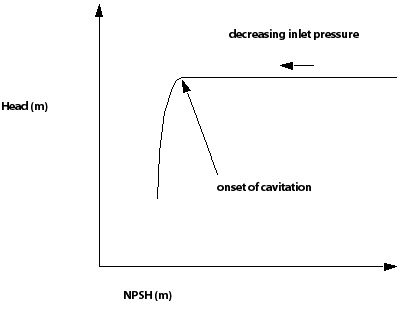If the inlet total pressure is below the critical value for a particular flow rate and RPM, cavitation will occur causing the pressure rise to diminish. The following performance diagram shows the effect of cavitation on pressure rise.
NPSH is the Net Positive Suction Head, a quantity directly related to the inlet total pressure by the relation:
(7–1) |
where p
T,inlet is
the inlet total pressure, p
v is the vapor pressure, is density, and g is the acceleration due to gravity. As the inlet total pressure
drops, so does the NPSH value, and the amount of cavitation increases.
To generate this diagram, RPM and flow rate are fixed, and the pressure rise is measured at progressively lower inlet total pressures. For the part of the test where the inlet total pressure is sufficiently high to prevent cavitation, the pressure rise across the pump is constant, equal to the amount predicted by the first performance diagram. This results in a horizontal trend in the performance curve as the inlet total pressure is dropped. Because the pressure rise remains constant, the total pressure at the outlet drops by the same amount as at the inlet. Using CFX software, a mass flow outlet boundary condition can be specified to fix the flow rate while the inlet total pressure is varied.
When the inlet total pressure reaches a sufficiently low value, cavitation occurs. A further reduction in inlet total pressure causes more cavitation, which almost always causes a large loss of pressure rise. In rare cases, pressure rise can actually increase slightly with small amounts of cavitation. Even in such cases, however, a further increase in cavitation causes a sudden loss of pressure rise. In the lab, the pressure rise will eventually become insufficient to maintain the required flow rate. Using CFX software, the solution will eventually fail to converge. Before this point, data should be collected with a sufficient resolution (sufficiently small changes in inlet pressure) to resolve the part of the performance curve where the pressure starts to drop. The point of cavitation is often marked by the NPSH at which the pressure rise has fallen by a few percent.



